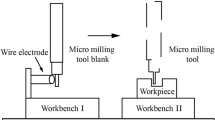Abstract
In manufacturing polycrystalline diamond (PCD) tools, the finishing process in order to obtain the required surface and edge quality and to remove the damaged PCD layer induced by the prior manufacturing steps is mostly done by grinding. However, grinding is currently inefficient and costly due to low material removal rates and high wear of the grinding wheel. The project “Pro-PKD” aims to increase throughput and reduce tool wear by an additional laser ablation step prior to grinding. In first process investigations, the influence of different laser parameters on the ablation rate was analyzed and an optimum parameter set for maximum ablation efficiency was found. By measuring the overall material removal from the grinding wheel and the PCD tool, it could be shown that the G-ratio can be increased by at least a factor of two. Furthermore, the time required for grinding can be significantly shortened. As the time needed for laser ablation is only several seconds, in this way the whole time required for the finishing process can be reduced. In any case, the combined process presented here has the distinct advantage that it can be implemented into already existing grinding machines with comparatively low investment costs.














Similar content being viewed by others
References
Abele E, Schramm B (2008) Using PCD for machining CGI with CO2 coolant system. Prod Eng Res Dev 2:165–169
Heath PJ (2011) Developments in applications of PCD tooling. J Mater Process Technol 116:31–38
Klocke F (2008) Manufacturing processes II, grinding, honing, lapping. Springer, Berlin
Lammer A (1988) Mechanical properties of polycrystalline diamonds. Mater Sci Technol 4:949–955
Tso PL, Liu YG (2002) Study on PCD machining. Int J Mach Tools Manuf 42:331–334
Zhang GF et al (2007) An experimental study on laser cutting mechanisms of polycrystalline diamond compacts. CIRP Ann Manuf Technol 56:201–204
Poprawe R (2011) Tailored light 2—laser application technology. Springer, Berlin, pp 343–349
Li Z, Wang J, Wu Q (2012) Ultrashort pulsed laser micromachining of polycrystalline diamond. Adv Mat Res 497:220–224
Li Z, Wang J, Wu Q (2012) Molecular dynamics simulation of the ablation process in ultrashort pulsed laser machining of polycrystalline diamond. Adv Mat Res 500:351–356
Yu AY-C, Donovan TM, Spicer WE (1968) Optical properties of cobalt. Phys Rev 167(3):670–673
Westraadt JE, Dubrovinskaia N, Neethling JH, Sigalas I (2007) Thermally stable polycrystalline diamond sintered with calcium carbonate. Diam Relat Mater 16:1929–1935
Weikert M (2005) Oberflächenstrukturieren mit ultrakurzen Laserpulsen. In: Laser in der Materialbearbeitung, Forschungsberichte des IFSW. Herbert Utz Verlag, München, p 33ff
Biermann D, Würz E (2009) A study of grinding silicon nitride and cemented carbide materials with diamond grinding wheels. Prod Eng Res Dev 3:411–416
Friemuth T (2002) Herstellung spanender Werkzeuge. Universität Hannover, Habilitation
Kenter M (1990) Schleifen von polykristallinem Diamant. Universität Bremen, Dissertation
Michels C (2003) Nur mit optimalem system Schleifen von CBN-/PKD-Werkzeugen, VDI-Z Special Werkzeuge
Pastewka L, Moser S (2011) Anisotropic mechanical amorphization drives wear in diamond. Nat Mater 10:34–38
Dold C et al (2012) Comparison of ground and laser machined polycrystalline diamond (PCD) tools in cutting carbon fiber reinforced plastics (CFRP) for aircraft structures. Procedia CIRP 1:178
Acknowledgments
The project is being funded within the framework of the Federal Ministry of Education and Research, program VIP.
Author information
Authors and Affiliations
Corresponding author
Rights and permissions
About this article
Cite this article
Brecher, C., Klocke, F., Schindler, F. et al. Finishing of polycrystalline diamond tools by combining laser ablation with grinding. Prod. Eng. Res. Devel. 7, 361–371 (2013). https://doi.org/10.1007/s11740-013-0462-6
Received:
Accepted:
Published:
Issue Date:
DOI: https://doi.org/10.1007/s11740-013-0462-6



